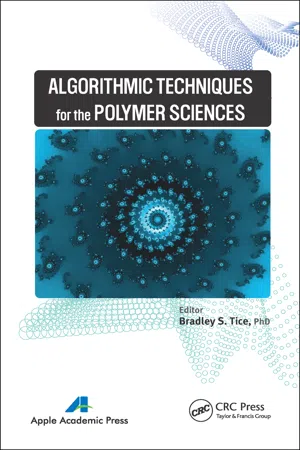
- 256 pages
- English
- PDF
- Available on iOS & Android
eBook - PDF
Algorithmic Techniques for the Polymer Sciences
About this book
This new book-the first of its kind-examines the use of algorithmic techniques to compress random and non-random sequential strings found in chains of polymers. The book is an introduction to algorithmic complexity. Examples taken from current research in the polymer sciences are used for compression of like-natured properties as found on a chain o
Frequently asked questions
Yes, you can cancel anytime from the Subscription tab in your account settings on the Perlego website. Your subscription will stay active until the end of your current billing period. Learn how to cancel your subscription.
At the moment all of our mobile-responsive ePub books are available to download via the app. Most of our PDFs are also available to download and we're working on making the final remaining ones downloadable now. Learn more here.
Perlego offers two plans: Essential and Complete
- Essential is ideal for learners and professionals who enjoy exploring a wide range of subjects. Access the Essential Library with 800,000+ trusted titles and best-sellers across business, personal growth, and the humanities. Includes unlimited reading time and Standard Read Aloud voice.
- Complete: Perfect for advanced learners and researchers needing full, unrestricted access. Unlock 1.4M+ books across hundreds of subjects, including academic and specialized titles. The Complete Plan also includes advanced features like Premium Read Aloud and Research Assistant.
We are an online textbook subscription service, where you can get access to an entire online library for less than the price of a single book per month. With over 1 million books across 1000+ topics, we’ve got you covered! Learn more here.
Look out for the read-aloud symbol on your next book to see if you can listen to it. The read-aloud tool reads text aloud for you, highlighting the text as it is being read. You can pause it, speed it up and slow it down. Learn more here.
Yes! You can use the Perlego app on both iOS or Android devices to read anytime, anywhere — even offline. Perfect for commutes or when you’re on the go.
Please note we cannot support devices running on iOS 13 and Android 7 or earlier. Learn more about using the app.
Please note we cannot support devices running on iOS 13 and Android 7 or earlier. Learn more about using the app.
Yes, you can access Algorithmic Techniques for the Polymer Sciences by Bradley S. Tice in PDF and/or ePUB format, as well as other popular books in Matematica & Aritmetica. We have over one million books available in our catalogue for you to explore.
Information
Table of contents
- Front Cover
- About the Editor
- Preface
- Contents
- Introduction
- Review of the Literature
- Chapter 1: Polymers
- Chapter 2: Compression of Data
- Chapter 3: Natural Language Compression
- Chapter 4: Formal Language Compression
- Chapter 5: Types of Compression Programs
- Chapter 6: Algorithmic Compression
- Chapter 7: Chemical Formulas
- Chapter 8: Fischer Projection
- Chapter 9: Compression of Polymers
- Chapter 10: Line Notation Systems and Compression
- Chapter 11: Current Trends in Research
- Chapter 12: Big Data
- Chapter 13: Modeling Complexity in Molecular Systems: A Revised Edition
- Chapter 14: Feedback Systems for Nontraditional Medicines: A Case for the Signal Flow Diagram
- Chapter 15: Chromatic Aspects of the Signal Flow Diagram
- Chapter 16: Junction Graphs
- Chapter 17: Embedded Symbol Notation Diagrams and Embedded Symbol Notation Matrix Diagrams
- Chapter 18: Feedback Theory: Properties of Signal Flow Graphs
- Chapter 19: An Overview of Signal Flow Graphs
- Chapter 20: A Theory on Neurological Systems-Part I and Part II
- Chapter 21: A Theoretical Model of Feedback in Pharmacology Using Signal Flow Diagrams
- Appendix A: A New Foundation for Information
- Appendix B: Compression and Geometric Data
- Appendix C: The Analysis of Binary, Ternary, and Quaternary Based Systems for Communications Theory
- Appendix D: The Use of a Radix 5 Base for Transmission and Storage of Information
- Appendix E: A Comparison of a Radix 2 and a Radix 5 Based Systems
- Appendix F: Random and Non-Random Sequential Strings Using a Radix 5 Based System
- Appendix G: A Comparison of Compression Values of Binary and Ternary Base Systems
- Appendix H: Patterns within Patternless Sequences
- Appendix I: A Radix 4 Based System for Use in Theoretical Genetics
- Appendix J: A Compression Program for Chemical, Biological, and Nanotechnologies
- Appendix K: Statistical Physics and the Fundamentals of Minimum Description Length and Minimum Message Length
- Appendix L: The Use of Signal Flow Diagrams in Pharmacology
- Appendix M: Signal Flow Diagrams Verses Block Diagrams
- Appendix N
- Appendix O
- Appendix P
- A List of the Editor’s Papers on Signal Flow Diagrams
- References